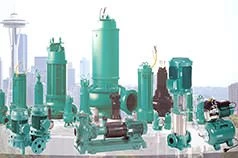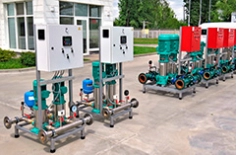Pump stations and pumps
 Individual heating station of the heating system according to an independent connection scheme
Individual heating station of the heating system according to an independent connection scheme
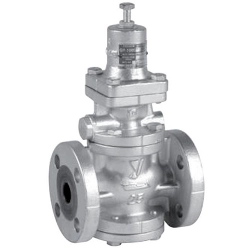 Reducing valve for steam Yoshitake GP-1000EN
Reducing valve for steam Yoshitake GP-1000EN
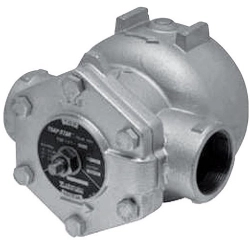 Float steam trap Yoshitake TSF-10
Float steam trap Yoshitake TSF-10
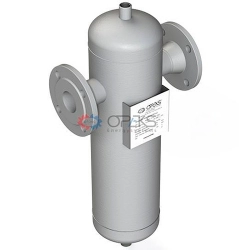 Centrifugal steam separator OPEKS-1-SC16-1-F50
Centrifugal steam separator OPEKS-1-SC16-1-F50
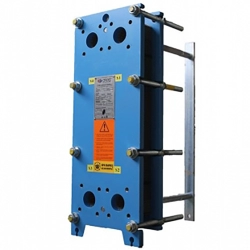 Plate heat exchanger THERMAKS РТА (GC)-16
Plate heat exchanger THERMAKS РТА (GC)-16
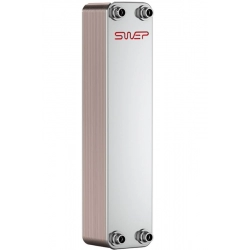 Brazed heat exchanger SWEP B25T
Brazed heat exchanger SWEP B25T
 Brazed heat exchanger SWEP B25THx20
Brazed heat exchanger SWEP B25THx20
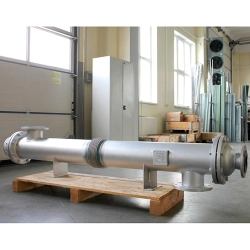 Shell and tube coolers
Shell and tube coolers
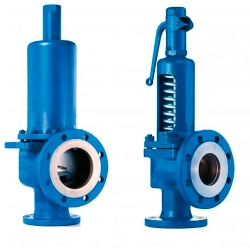 Safety valve LESER 441/442
Safety valve LESER 441/442
What is a pumping station

- by the principle of action and design;
- by the nature of the pumped medium;
- industrial and economic purposes;
- design features of the production of various companies: WILO, Grundfos, SAER, PEDROLLO, Airtex, SOLTEC, IWT, etc.
All this, as a rule, is high-tech and high-performance pumping equipment that fully meets the typical operating conditions. But it is known that the specific conditions of their use are also characterized by a wide variety of important operational parameters: the required delivery height (pressure), the actual operating mode, the conditions for ensuring installation, power supply,
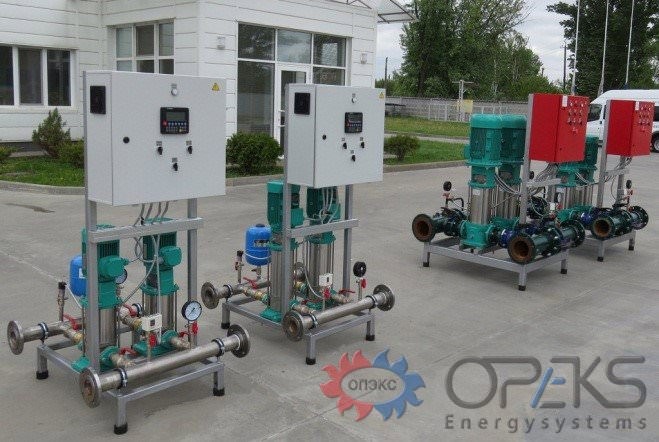
- control automation;
- ensuring electrical and hydraulic safety;
- cooling and protection against working overloads;
- organization of connection to a specific pipeline system;
- protection from the effects of atmospheric precipitation and unauthorized third-party intervention;
- providing vibration protection of pumping equipment and installation system;
- ensuring noise and vibration protection of working personnel, and sometimes - of the surrounding people, buildings and structures.
Thus, a pumping station is a technical complex built on the basis of an industrial (economic) hydraulic pump in order to ensure its most efficient, economical and safe use in specific operating conditions, as well as to protect personnel and the environment from harmful technogenic impact from the pumping station. equipment.
Design features of pumping stations HYDROMAKS
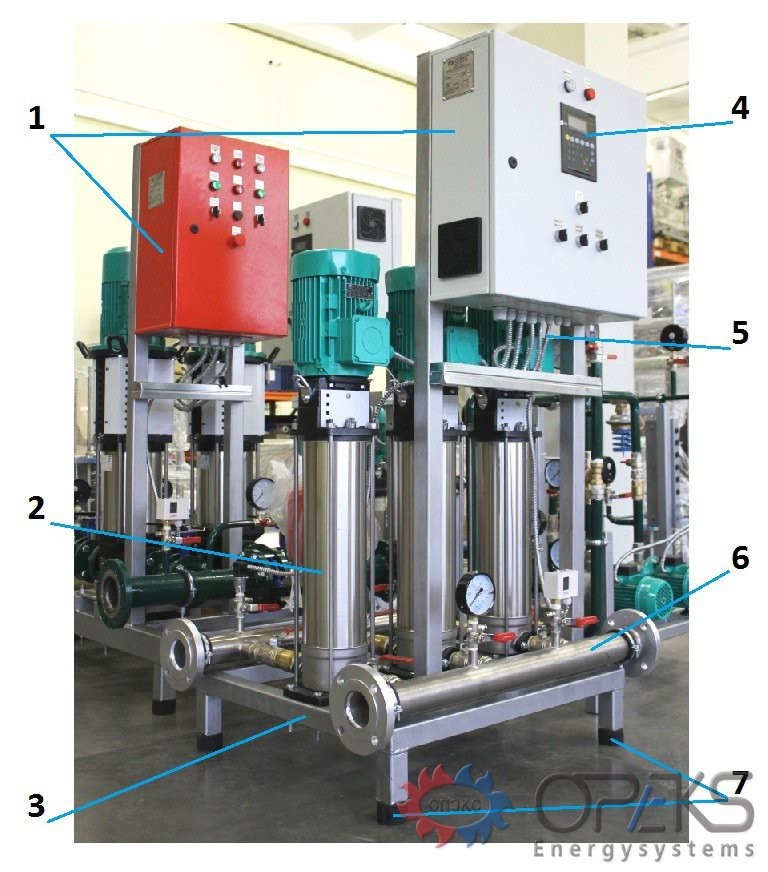
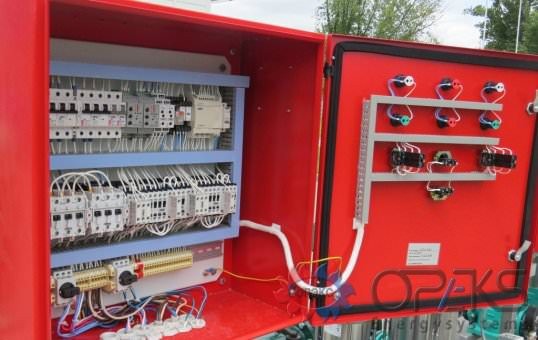
1 - control cabinet (ШУ)
ShU fire extinguishing station
- starters, automatic devices, relays - ETI (Slovenia) as standard, ABB, Moeller - on request;
- phase control relay - standard;
- built-in motor protection against overload and dry running;
- manual control mode through starters;
- Danfoss KP, KPI pressure switches are installed;
- protection classes of cabinets IP44, IP54.
ShU water supply station
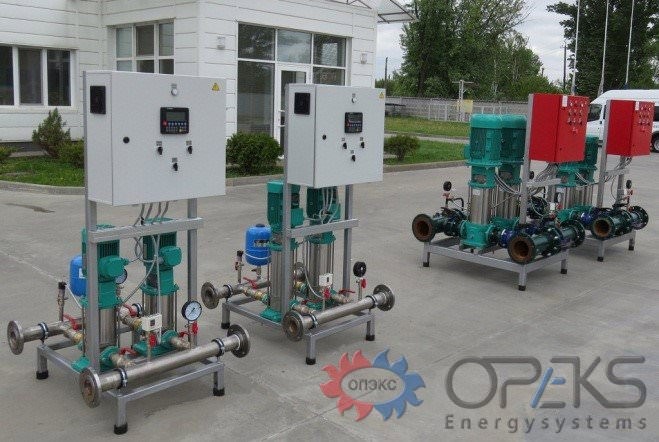
- frequency converters ABB or Danfoss - standard;
starters, automatic devices, relays - ETI (Slovenia) as standard, ABB, Moeller - on request;
- Danfoss KP, KPI pressure switches are installed; phase control relays are standard;
- built-in motor protection against overload and dry running;
- manual control mode through starters;
- built-in cooling fan of the frequency converter;
- protection classes of cabinets IP44, IP54.
Cantilever, multistage vertical or horizontal pumps manufactured by WILO, Grundfos and others upon request can be used as part of pumping stations.
2 - pumps
Characteristic:
- the installation uses from 1 to 6 pumps;
- power supply 3-phase network 220V / 380V ± 10%, 50 Hz;
- working pressure 10, 16 bar, others on request;
- pumped water temperature 50 ° C, options up to 180 ° C are possible on request;
- the pump shaft is made of 1.4057 stainless steel;
- impellers are made of stainless steel 1.4307 (for multistage pumps), for block pumps - from cast iron EN-GJL-200 or bronze. Other options on request;
- the maximum values of the head can reach 160 mWC;
- maximum flow (flow) values can reach 700 m3 / h.
3 - supporting frame

For all OPEKSX ENERGOSYSTEMY pumping stations, a reinforced supporting frame is manufactured, the strength of which is designed for the weight of the entire pressure boosting system, taking into account the filling with water. The frame allows installation and piping without additional foundation. The base frame is available in stainless steel or painted black steel (standard).
4 - controller
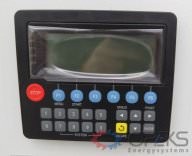
The automation works with a freely programmable Segnetics controller, in the standard version of the installation, maintaining the set frequency by means of a frequency converter. Versions with Siemens controllers and others are possible.
5 - power cables

In the production of pressure boosting systems, power cables of the required cross-section of domestic and European manufacturers are used. The cable is placed in a protective galvanized steel corrugated pipe and pulled in a galvanized steel box. This design provides additional protection against mechanical damage to the cable.
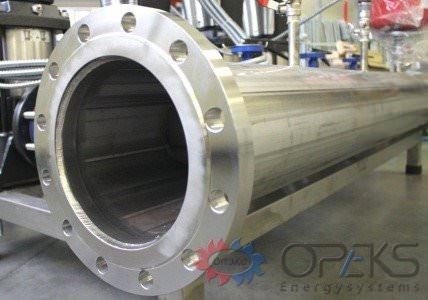
6 - suction and discharge manifold
Own production of the company OPEKS ENERGOSYSTEMY. Material - high quality stainless steel AISI304 for water stations and black painted steel for fire pumping stations as standard.
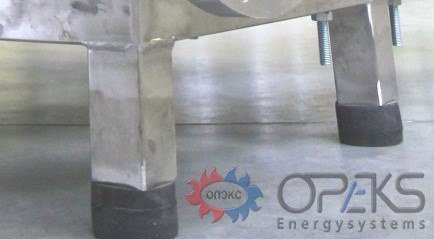
7 - vibration mounts
To prevent the transmission of vibration from the operating pumps through the supporting structures, the floor, vibration damping supports made of hard pressed rubber are provided in the frame of the pumping unit.
Pumping station device
Since a pumping station is a complex technical solution, the architecture of which depends on the specific operating conditions, it is more likely that it is not a question of its design, but of a complete set.
At the heart of the pumping station is the actual hydraulic pump of the corresponding type and purpose. For the overall and power parameters of the pump, and often for the specific conditions of placement (installation), the mounting frame of the pumping station is designed. Sometimes container-type pumping stations are created, located in a closed, including noise-insulated, container. An important structural element of such a mounting frame (container) is vibration mounts, which protect the equipment from the harmful effects of high-frequency vibrations.
In addition to the hydraulic pump, all other components of the pumping station are attached to this frame (container):
- control equipment (panels and controllers), including a set of necessary instrumentation and sensors (instrumentation and automation), which provide multifactor control and control of operating parameters: manual, automated, software.
- electrical equipment that converts the voltage of an industrial or household network into starting and operating electric currents for supplying pumping equipment, its protection from network and operating overloads, overheating and accidents (short circuit);
- hydraulic engineering protective equipment (safety, bypass valves), which protect the pump from emergency pressure drops in the system, water hammer, etc.;
- pump cooling system: forced air or liquid;
- connecting manifolds and branch pipes for connecting the pump to pipeline networks;
- a set of power cables of the appropriate cross-section and insulation quality, which ensure the connection of the station to the power supply network, in compliance with all the necessary requirements / standards of electrical and fire safety;
- inlet filters and steam-air valves that clean the working medium from mechanical and air-gas impurities.
Types and purpose of hydraulic stations
The type (type) of the pumping station and its practical (industrial, economic) purpose is very closely related to the type and purpose of the hydraulic pump on the basis of which it is built.
The modern typology of hydraulic pumps for household and industrial use is wide and varied. The main types of hydraulic pumps most popular in industry and economy include:
- volumetric structural type, and its varieties: vane, screw, piston, peristaltic, vane, diaphragm pumps, and others. Positive displacement pumps are characterized by a cyclic head, which makes it possible to feed portions, as well as constant hermetic separation of the supply and pressure hydraulic lines, the effect of the independence of the pressure of the head from the pressure in the supply line.
- dynamic constructional type, and its varieties: blade, propeller, gear, vortex, and others. Pumps of dynamic type are characterized by continuous flow, low noise and low vibration loads, relative technical simplicity of implementation and low cost, better cope with pumping viscous and contaminated media.
The industrial and economic purpose of hydraulic pumps is no less wide and varied. In particular, I distinguish between hydraulic pumps:
- water, including for cold and hot water supply, firefighters, watering (irrigation), drainage, mine, artesian, sea (for sea water), etc.;
- food - for pumping drinking liquids, liquid and viscous components used in food production;
- chemical - for pumping a variety of industrial chemicals, including chemically active (aggressive), such as glycols, acids, alkalis, phenols, etc.
- oil (including oil, fuel, bitumen) - used in the oil and petrochemical industries, the infrastructure for the storage and sale of petroleum products;
- construction concrete pumps for dispensing and supplying liquid concrete mixture;
- waste-mass (including fecal) - for pumping highly contaminated media.
Selection of a pumping station
When selecting a pumping station, the defining parameters are:
- the nature of the pumped-over working medium;
- solved industrial and economic problems, the envisaged operating mode;
- the required degree of control automation;
- required working pressure of the medium (delivery head, head) in the delivery line;
- the pressure of the medium in the supply hydraulic line;
- temperature range (working, maximum, minimum temperature) of the working environment;
- required capacity of the pumping station;
- conditions for providing power supply at the installation site;
- placement conditions, including atmospheric and noise protection at the installation site.
Installation and operation
A powerful and high-performance pumping station for industrial or economic purposes is a rather complex and expensive technical complex, with very complicated operating rules and very serious warranty obligations from its manufacturer (manufacturer).
The installation and commissioning of such a station at the facility, as a rule, should be carried out by representatives of the direct manufacturer's plant. Also, such a station, purchased directly from the manufacturer, is subject to proprietary technical support and service programs, which greatly simplify and reduce the cost of its further operation, and extend its service life.
An important issue is the professional training of service personnel for the pumping station. Reliability, efficiency and economy of pumping equipment operation and its service life largely depend on his qualifications. Many reputable manufacturing companies offer appropriate training programs for service personnel for their pumping equipment, which should not be neglected in any case.
Design features of pumping stations HYDROMAKS
OPEKS Energosystems produces a series of its pumping stations for water supply under the HYDROMAKS trademark. The design of TM HYDROMAKS pumping stations is based only on high-quality, high-tech water pumps and control automation from well-known European manufacturers WILO, Grundfoss, ETI, ABB, Moeller, Danfoss . At the same time, some of the HYDROMAKS TM component stations, such as the frame, branch pipes and manifolds, the cooling system and others, are their own production, which significantly reduces the cost of the overall design of the equipment, without losing its quality.
Thus, HYDROMAKS pumping stations have quality, functionality, productivity, technical reliability, which are comparable to pumping equipment, for example, from German manufacturers (the same WILO, Grundfoss). While their cost is as close as possible to the conditions of the domestic market, and is quite affordable for domestic consumers (customers).

